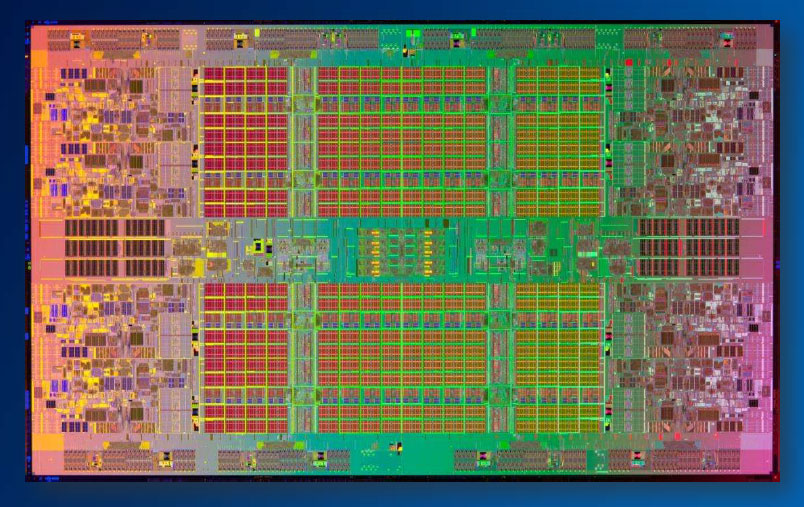Intel Releases Itanium 9500, Packing Up to 8 Cores
Intel released the 32 nm generation of its Itanium processor series, now known as the 9500-series.
The new product family, formerly code-named Poulson, succeeds the 65 nm 9300 series, code-named Tukwila, which was launched in February 2008.
Poulson represents a major shift in Intel's Itanium strategy. It is still the company's mainframe processor, but its focus is changing from legacy mainframe installations to a cloud infrastructure, both for private clouds as as well as cloud environments that are operated to enable a service model. Intel is also aligning the new Itanium much closer to its x86 architecture, making the 9500-series compatible with the Xeon E7 processor's 7500-series chipset. Intel noted that the new Itanium also shares the Xeon's memory buffer, interconnect and "industry standard" memory to make the Itanium more cost-efficient to produce.
Compared to its predecessor, the Itanium 9500 delivers up to 2.4x improved performance and 33 percent greater bandwidth. the 3.1 billion transistor chip integrates up to 54 MB on-die memory, and supports up to 2 TB of low voltage DIMMs in a four-socket configuration. The power band is also slightly improved. Whereas the 9300 series ran from 1.6 GHz to 1.73 GHz at 130 watts to 185 watts, the 9500 series is clocked from 1.73 GHz to 2.53 GHz and rated at a maximum power consumption of 130 watts to 170 watts.
At launch, Intel is offered four versions of the 32 nm Itanium. The 9520 (quad-core, 1.73 GHz), 9540 (8-core, 2.13 GHz), 9550 (quad-core, 2.4 GHz), and 9560 (8-core, 2.53 GHz). Tray-pricing starts at $1,350 for the 9520 and tops out at $4,650 for the 9560.
Contact Us for News Tips, Corrections and Feedback
Get Tom's Hardware's best news and in-depth reviews, straight to your inbox.

Wolfgang Gruener is an experienced professional in digital strategy and content, specializing in web strategy, content architecture, user experience, and applying AI in content operations within the insurtech industry. His previous roles include Director, Digital Strategy and Content Experience at American Eagle, Managing Editor at TG Daily, and contributing to publications like Tom's Guide and Tom's Hardware.
-
devBunny Like me, you may be wondering.... why?Reply
http://arstechnica.com/business/2011/06/ask-ars-why-itaniumask-ars-with-xeons-improvement-why-bother-with-itanium/ -
Estix Replyand supports up to 2 TB of low voltage DIMMs in a four-socket configuration
Jesus, 512GB DIMMs? Or am I misinterpretting that? -
SuperVeloce EstixJesus, 512GB DIMMs? Or am I misinterpretting that?I think it means 4 cpu sockets (equals 4 memory controllers)... and many many dimmsReply -
Estix SuperVeloceI think it means 4 cpu sockets (equals 4 memory controllers)... and many many dimmsReply
That makes more sense. (And here I had gotten my hopes up :P ) -
joebob2000 EstixThat makes more sense. (And here I had gotten my hopes up )Reply
You can already buy 32GB on a single DIMM, it won't be long before we get to 512. -
joebob2000 devBunnyLike me, you may be wondering.... why?http://arstechnica.com/business/20 h-itanium/Reply
"Now, this $4 billion number is a lot smaller than $30 billion, which is the size of Intel's Xeon business. But it's a lot larger than $1.6 billion, which was the revenue for all of AMD combined (CPUs, GPUs—the whole company) in the first quarter of 2011."
oops, a year is not a quarter. Ars fail. full stop. -
InvalidError EstixThat makes more sense. (And here I had gotten my hopes up )And that "lot of DIMMs" would be buffered 32 chips quad-bank (think two dual-sided DIMMs smashed into one) DIMMs... four of them per channel, four channels per CPU, 64 DIMMs total.Reply
Maxed out, such a monster must be an interesting thing to behold at least for the first few times around. -
nforce4max 170w per chip, that is twice as much as what I have in my old Xeon rig :oReply
At least they moved it to a common socket so maybe in the long run Itanium might gain market share.
